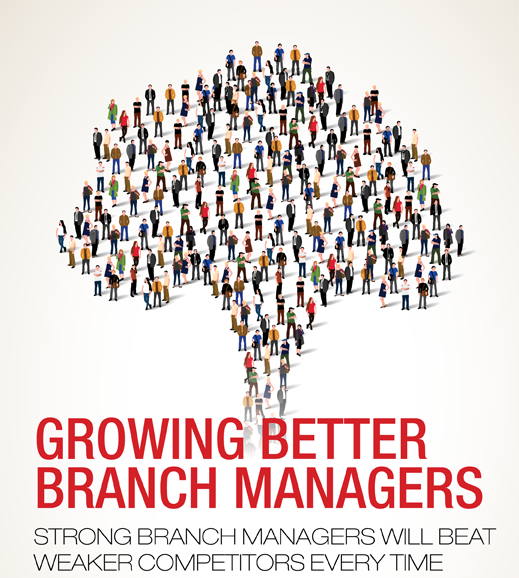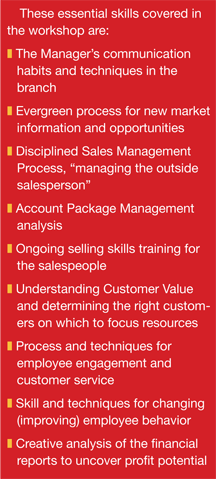Growing better branch managers

by Jim Ambrose
The branch manager position contributes most to the success of the industrial distributor. Regardless of operating structure and logistics, the distributor’s business is geographically defined in terms of where each branch is located. The sum of each branch performance determines the company’s performance.
The branch level is where the company’s brilliance and strategy meet market reality.
 The branch market space is the Ground Zero, real-world space for the wholesale distributor. This is where the branch manager operates.
The branch market space is the Ground Zero, real-world space for the wholesale distributor. This is where the branch manager operates.
I have worked with many wholesale distributors across several trade groups in the United States and Canada, each with various organizational structures: central distribution centers (CDC), hub and spoke branches, and stand-alone profit and loss (P&L) centers, to name a few of the most common.
In all cases, the success of the strategy was based on the business and leadership skills of the branch manager.
A strong branch manager will beat the weaker branch manager of the competitor regardless of strategy or structure.
I look at the branch manager position as the person at the market level that drives the performance of the business. Titles may vary by company, but the people responsible for the sales and customer service of the business at the market level determine the success of that company in each market.
Throughout my career, I have had branch managers report to me that were quite good at the button-pushing aspects of the job: they understood inventory processes and the back office paperwork, had excellent product knowledge, and could and would jump in and fill in at any function in the branch. But, their business was in what I refer to as the “subway.” Some years were up, some years were down.
They were excellent mechanical managers, but they did not possess good business and leadership skills. The demand for my Business Skills and Leadership Training Workshop proves that progressive distributors realize the important role of the branch manager and the need for a higher level of training.
These essential skills covered in the workshop are:
- The Manager’s communication habits and techniques in the branch
- Evergreen process for new market information and opportunities
- Disciplined Sales Management Process, “managing the outside salesperson”
- Account Package Management analysis
- Ongoing selling skills training for the salespeople
- Understanding Customer Value and determining the right customers on which to focus resources
- Process and techniques for employee engagement and customer service
- Skill and techniques for changing (improving) employee behavior
- Creative analysis of the financial reports to uncover profit potential
I first wrote about these skills in a book entitled 5 Fundamentals for the Wholesale Distribution Branch Manager. It was published by NAW and quickly became a perennial best seller. The Second Edition is now out.
In the Second Edition, I introduce the term “net speed” as an essential ingredient in growing profitable market share. Net Speed is being perfect at everything the chosen customers value. You cannot be perfect without focused resources and employee engagement. This alignment and fine tuning of the business can only be done by the manager at ground zero, by the branch manager with excellent business and leadership skills over and above knowing how to “run the branch.”
As the subway business goes slow and goes fast, goes up and goes down, the business that is aligned tends to always go faster. Alignment is necessary for acceleration. Branch manager training and development of the tools for alignment is what sets apart the winning distributors.
The 5 Fundamentals for the Wholesale Distribution Branch Manager is an excellent resource in understanding how to create this alignment.
Fundamental One
The First Fundamental explains how the branch manager can always be ahead of the competition in market knowledge and opportunities. A lot of money and time is spent to understand the macro industry ratios, overall trends and industry bench marks. They are nice to know, but, what is going on real time in the specific market is the information that the branch manager needs to constantly receive in order to quickly position resources and effort at profitable share gain opportunities.
I call this evergreen market information the 5,000-foot view. My hobby is flying airplanes. I noticed on a flight several years ago to a city to meet a direct report branch manager, that, when being cleared down to 5,000 feet for arrival into the airport area, I could see the entire infrastructure of the city and all the activity. The view from 5,000 feet uncovers changes going on in commercial areas, residential areas, transportation and infrastructure, and it is always in some state of change. The branch manager needs to work on finding ways to continually receive this information going on in his market in order to position his efforts and resources to take advantage of new opportunities. With the right technique, he could learn of changes in customer preferences, purchasing influences and growth opportunities long before it is known by his competitors.
The new branch manager arriving in from outside the area at first spends a lot of time working on gaining market information. The new manager is focused on asking questions and seeking information on the market landscape. The effort fades after the first year and the manager sits behind his desk thinking he knows the market and becomes busy “running the branch.” He might as well be looking at a one dimensional street map from a park bench. A lot of things are happening and he is missing it.
Fundamental Two
Fundamental Two deals with the communication habits and leadership skills of the branch manager. I have seen and worked with very smart and market savvy managers, yet they struggle to significantly improve performance because their employees are cowering and intimidated by their management style, reflected in how they communicate.
Surveys of thousands of employees of managers attending my workshops confirm that this issue of the manager’s communication style is very prominent and highly impactful to employee engagement and branch performance. In my personal experience with direct reports, when I would bring up the subject of their rather rough communication style, the branch manager would dismiss it as “oh they know me,” or “they are used to it,” or “they know I don’t mean anything by it.”
In fact, it is a big issue! It hinders employee engagement and productivity.
Before we can present business and leadership tool kits, we have to “expose” the manager to the fact that his communication habits could be a huge impediment to just about anything they are trying to accomplish with the business. We present communication style tool kits and self-awareness modules in order to improve how they communicate with branch employees.
Fundamental Three
Fundamental Three can only happen once the manager has mastered the first two Fundamentals. Fundamental Three is all about employee engagement to provide value to the right customers. Think about how many employee touch points to a customer you have in a typical day as an industrial distributor. Every touch point is a critical moment of employee motivation. Since an order is either 100% perfect or a mistake, every touch point is a pass or fail moment.
I have watched many managers try to improve customer service with a passionate and vociferous speech at their weekly or monthly meetings about customer service. But, there is very little change in the way people do things and problems get repeated with the comment that “someone needs to fix this” by a frustrated employee. The fix is to provide a pathway for the employees to eagerly engage in fixing issues and impediments to customer service.
This pathway is a fun, simple yet powerful tool I call the “Mini-Huddle.” The Mini-Huddle is a series of steps that pull together various people in the branch to find the cause and effect of events leading to the customer service problems. The employees welcome the opportunity to fix things that cause them more work and in the process eliminate the habits that cause the customer service problems. Fundamental Three provides a powerful process to improve customer service and employee engagement. When visiting a branch, I have a good idea of the level of customer service (as perceived by the customer) by the degree of employee engagement in the business.
Customer service is a direct correlation to employee engagement. Low employee engagement equals low customer service.
Fundamental Four
Fundamental Four is a tool kit for disciplined sales management. Outside salespeople are an expensive investment that must constantly be performing in a way that drives business growth and profitability. Think about the top line of your financial report, the total sales line as a summary of the account package portfolios in your branch. How the account packages perform is directly influenced by the skills and attitudes of the outside salespeople, which are the direct result of the branch manager’s sales management skills.
Even our best salespeople need direction and boundaries that fit the business goals.
My survey data confirms that branch managers feel their toughest job is managing the outside salespeople. They are right. That is a tough job and a very important part of the success of the branch. That is why it is Fundamental Four. This fundamental includes the tools to analyze account packages, compensation and performance expectations. The important part of Fundamental Four is to manage the outside sales performance to fit the branch business goals.
I have heard branch managers explain their goal for the coming year without any corresponding match of the portfolio of account packages, and I have seen salespeople explain their account package plans for the year that in aggregate will create a shortfall in expected branch performance.
An important aspect in aligning the branch is managing the resource of outside sales activity to match the overall business strategy.
Recently, I published Cracking Accounts, a selling skills and sales management tool kit for the wholesale distribution industry. In the book, I explain my three steps in sales management: AIM the salesforce and the business, ARM the salespeople with product and services reflecting your business, and teach selling skills to better ENGAGE the customer. Sales and sales management are an integral part of the overall branch success and they directly impact what investment should be made in the operations side of the business.
Fundamentals One through Four address market awareness, personal leadership style, engaging the employees in the business, and effective sales management techniques.
Fundamental Five
The fifth fundamental is about the financial reports on the branch performance. This fundamental has two parts. The first part is a primer on the basic financial report and its components. It explains how the numbers impact the bottom line.
The second part is where the fun and creativity happen. We have many commonly used ratios: gross profit rate, inventory turnover, accounts receivable, accounts payable and turn-and-earn, to name a few. There are a few common variances, such as the change in total sales this year over last, expressed as “sales are up 10% this year.” But, what is really revealing is creating your own ratios of various line items to sales or gross profit dollars or inventory investment, etc., and then applying variance analysis to the ratios over time. I refer to this as uncovering the branch organizational behavior by reviewing your financial data. Your data over time is what is important. Benchmark data in the industry is nice to know, but working your particular branch financial data and how it changes over time is Fundamental Five.
All the actions in the branch eventually turn into financial data somewhere on the reports. Many opportunities to uncover a profit leak, find where resources are being wasted, and spot good or bad trends early in the cycle will be missed if the branch manager simply looks at the bottom line every month to make sure things are “okay.”
Fundamental Five is to have fun doing creative analysis of the branch financial reports.
The Five Fundamentals will insure you are not just the mechanical manager “running” your branch, but a top-performing business leader winning in the industrial wholesale distribution industry!
 Jim Ambrose has been engaged in wholesale distribution sales and management positions for over 40 years. He is a popular speaker and author of the best selling books, Five Fundamentals for the Wholesale Distribution Branch Manager published by NAW and My Business Analysis and Cracking Accounts, published by Jim Ambrose Workshops. His series of workshops on business skills and leadership training for the branch manager and on selling skills for the outside salesperson offer valuable training for managers across all trades. Visit www.jimambroseworkshops.com for more information.
Jim Ambrose has been engaged in wholesale distribution sales and management positions for over 40 years. He is a popular speaker and author of the best selling books, Five Fundamentals for the Wholesale Distribution Branch Manager published by NAW and My Business Analysis and Cracking Accounts, published by Jim Ambrose Workshops. His series of workshops on business skills and leadership training for the branch manager and on selling skills for the outside salesperson offer valuable training for managers across all trades. Visit www.jimambroseworkshops.com for more information.
This article originally appeared in the Jan./Feb. 2016 issue of Industrial Supply magazine. Copyright 2016, Direct Business Media.













